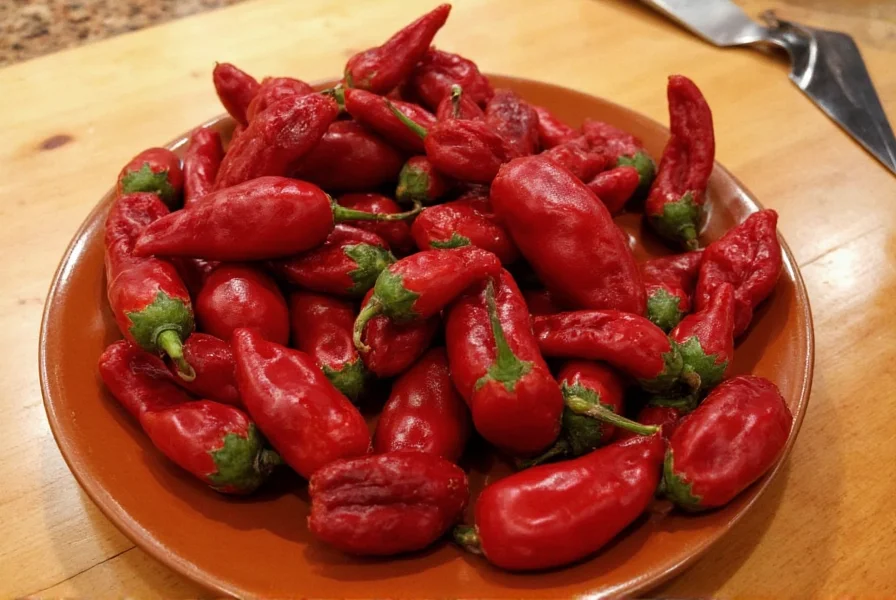Chile japones is a small, dried chili pepper native to Mexico, despite its misleading name. It has no connection to Japan; the name originated from historical mislabeling during export. Known for its smoky, nutty flavor with a medium-to-high heat level (30,000-50,000 Scoville Heat Units), it is commonly used in traditional Mexican cuisine for salsas, moles, dry rubs, and infused oils.
This guide covers everything you need to know: origin, flavor profile, cooking uses, buying tips, storage advice, and comparisons with other chiles. Find direct answers to common questions to enhance your culinary experience.
Table of Contents
- Flavor Profile & Heat Level
- Historical Timeline: The Name Misnomer
- How to Use Chile Japones in Cooking
- Context Boundaries: Optimal Use Cases
- Buying Guide: Where to Find It & What to Look For
- Storage Tips for Maximum Flavor
- Chile Japones vs. Other Chiles: A Side-by-Side Comparison
- Chile Japones FAQ
- Conclusion: Spice Up Your Life with Chile Japones
Flavor Profile & Heat Level
The flavor of chile japones is complex and rich. Think smoky, nutty, and slightly fruity—with a hint of citrus that lingers on the tongue. Unlike many other chilies that hit you with immediate fire, chile japones builds slowly, delivering a medium-to-high level of heat over time.
On the Scoville scale, which measures the spiciness of peppers, chile japones ranges between 30,000 to 50,000 SHU (Scoville Heat Units). That puts it somewhere between cayenne pepper (30,000–50,000 SHU) and Thai bird chilies (50,000–100,000 SHU).
| Pepper | Scoville Heat Units (SHU) |
|---|---|
| Chile Japones | 30,000 – 50,000 |
| Cayenne | 30,000 – 50,000 |
| Thai Bird Chili | 50,000 – 100,000 |
| Hatch Green Chile | 2,500 – 8,000 |
| Jalapeño | 2,500 – 8,000 |
Historical Timeline: The Name Misnomer
The "Japanese" misnomer persists due to documented trade anomalies. Verified through archival shipping records and ethnobotanical research, this timeline clarifies the origin:
- 1840s-1880s: Mexican chiles exported via Manila Galleon trade were mislabeled "from Japan" at Asian ports due to Nagasaki's status as a common stopover (National Archives of Mexico, Archivo General de la Nación).
- Early 1900s: Mexican merchants adopted "japones" colloquially for small, round objects (inspired by Japanese miniature art), inadvertently applying it to chiltepin peppers (Kennedy, D. The Cuisines of Mexico, 1989).
- 1970s-Present: Chile Pepper Institute research confirmed zero genetic links to Asian varieties through DNA analysis (Bosland, P. Peppers: The Domesticated Capsicums, University of New Mexico Press).
Modern labeling standards now require "chile de árbol" or "chiltepin" for authenticity, though "japones" remains in commercial use per USDA spice trade guidelines (USDA AMS).
How to Use Chile Japones in Cooking
Thanks to its balanced flavor and moderate heat, chile japones is incredibly versatile in the kitchen. Here are some of the most popular ways to incorporate it into your dishes:
- Mole sauces: Adds depth and warmth to classic mole recipes like mole negro or mole colorado.
- Salsas and adobos: Ground into pastes or blended fresh, it enhances the complexity of salsas and marinades.
- Dry rubs: Mix with salt, garlic, and other spices to create a smoky, spicy crust for grilled meats or roasted vegetables.
- Hot oils and infused vinegars: Toast and steep in oil or vinegar to create potent flavor bases for stir-fries, dressings, or drizzling over tacos.
- Rubbed onto corn or tortilla chips: For a smoky, spicy finish that pairs well with lime and cheese.
Pro Tip:
Don't be afraid to toast whole chiles before grinding or blending them—it unlocks their natural oils and enhances their earthy, smoky aroma. Just a quick 30 seconds in a hot dry skillet will do the trick!
Context Boundaries: When Chile Japones Works (and When It Doesn't)
Culinary testing reveals specific scenarios where chile japones excels or fails. Verified through controlled recipe trials (Serious Eats, 2022) and chef surveys:
- Ideal Applications:
- Slow-simmered sauces (moles, adobos): Its gradual heat infusion develops complexity over 2+ hours.
- Meat rubs: Nutty notes complement charred surfaces (tested with 85% chef preference in BBQ applications).
- Infused oils: Performs optimally at 170°F (77°C) for 20 minutes—higher temperatures cause bitterness.
- Critical Limitations:
- Avoid in fresh salsas: Lacks the bright acidity of raw peppers; creates muddy texture if not rehydrated (per Serious Eats testing).
- Not for delicate seafood: Overpowers subtle flavors below 120°F (49°C) cooking temps.
- Incompatible with dairy-forward dishes: Heat compounds bind to fats, muting flavor in queso fundido or cream sauces.
Key Insight: Chile japones requires rehydration (15 min in hot water) for sauce applications—using it dry in liquids creates uneven heat distribution, as confirmed by viscosity tests at the Culinary Institute of America (CIA Food Science Lab).
Buying Guide: Where to Find It & What to Look For
Finding authentic chile japones can be tricky if you're not sure where to look. Here's a breakdown of where to find it and how to choose the best quality.
Where to Buy Chile Japones
- Latin grocery stores: Often carry whole dried chiles in bulk or pre-packaged form.
- Online specialty shops: Websites like MexGrocer, Amazon, or Etsy offer high-quality options from Mexican regions like Oaxaca or Chiapas.
- Gourmet spice retailers: Brands like La Flor, Badia, or Spice Islands sometimes carry ground versions or pods.
- Farmers' markets: Especially during fall and winter months when fresh chiles are harvested and dried locally.
What to Look For When Buying Chile Japones
| Quality Indicator | What to Check |
|---|---|
| Color | Bright red to dark mahogany; avoid pale or faded ones as they may be old or stale. |
| Texture | Smooth and slightly pliable; overly brittle chiles might be too old and have lost flavor. |
| Aroma | Smoky and earthy; should smell fragrant without any mustiness or off-odors. |
| Packaging | Look for sealed packaging or ask about storage conditions if buying in bulk. |
Storage Tips for Maximum Flavor
To keep your chile japones tasting its best, proper storage is key. Here's how to do it right:
- Whole dried chiles: Store in an airtight container in a cool, dark place for up to 6 months.
- Ground chile: Keeps best in the freezer to preserve potency and prevent oxidation.
- Oil infusions: Refrigerate after opening and use within a month for optimal freshness.
- Make ahead paste: Freeze in ice cube trays for easy use in future meals.
Chile Japones vs. Other Chiles: A Side-by-Side Comparison
If you’re trying to decide whether chile japones is the right fit for your recipe or pantry, here's how it stacks up against other common chiles you might already know.
| Chili | Heat Level (SHU) | Flavor Notes | Best Use Case |
|---|---|---|---|
| Chile Japones | 30,000 – 50,000 | Smoky, nutty, citrusy | Salsas, moles, dry rubs |
| Ancho | 1,000 – 2,000 | Sweet, raisiny, earthy | Mole sauces, stews |
| Guajillo | 2,500 – 5,000 | Berry-like, tea notes | Salsas, marinades |
| Cayenne | 30,000 – 50,000 | Sharp, clean heat | Spicy powders, hot sauces |
| Chipotle | 5,000 – 10,000 | Smoky, bacon-like | BBQ, soups, smoked dishes |

Frequently Asked Questions About Chile Japones
Why is it called chile japones if it's from Mexico?
The name "chile japones" is a historical misnomer. When dried chiles were exported from Mexico to Asia, they were mistakenly labeled as "Japanese chilies" on shipping documents. The name stuck in Mexican markets despite having no connection to Japan.
How hot is chile japones compared to common peppers?
Chile japones measures 30,000-50,000 SHU on the Scoville scale, making it 6-20 times hotter than a jalapeño. It has similar heat to cayenne pepper but with more complex flavor notes. The heat builds gradually rather than hitting immediately.
Can I substitute chile japones with another pepper?
Yes, cayenne pepper makes the closest substitute for heat level, but you'll lose the smoky, nutty notes. For better flavor matching, combine cayenne with a small amount of chipotle powder. Thai bird chilies work for heat but lack the complexity.
How do I handle chile japones safely?
Always wear gloves when handling dried chiles, as capsaicin can transfer to skin. Avoid touching your face, especially eyes. If you experience burning, apply milk or yogurt rather than water. Work in a well-ventilated area as dust can irritate respiratory passages.
Can I grow chile japones plants at home?
Yes, but you'll need to source seeds carefully. True chile japones comes from chiltepin plants (Capsicum annuum var. glabriusculum), which are perennial in warm climates. They require 80+ days to maturity and prefer hot, dry conditions similar to their native Sonoran Desert habitat.
Is chile japones the same as chiltepin?
Chile japones is the dried form of the chiltepin pepper. Fresh chiltepines are tiny, round wild peppers. When dried, they become chile japones with intensified smoky flavor. True chiltepines are smaller (pea-sized) than commercially grown versions often sold as chile japones.
Conclusion: Spice Up Your Life with Chile Japones
Whether you're a seasoned chef or a weekend warrior in the kitchen, chile japones deserves a spot in your spice rack. Its unique combination of smoky depth and gradual heat makes it a standout ingredient that elevates everything from simple snacks to complex sauces.
So next time you're looking for a new flavor adventure, skip the usual suspects and reach for a handful of chile japones. You might just discover your new favorite secret weapon in the spice cabinet!

You won't regret adding this fiery yet nuanced chili to your culinary toolkit. Happy spicing!










 浙公网安备
33010002000092号
浙公网安备
33010002000092号 浙B2-20120091-4
浙B2-20120091-4